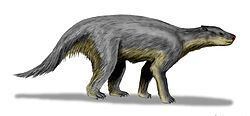Rank Order | Phylum Chordata | |
 | ||
Similar | ||
Cimolesta (from Greek, literally, "White Clay Thieves") is an extinct order of non-placental eutherian mammals. Cimolestans had a wide variety of body shapes, dentition and lifestyles, though the majority of them were small to medium-sized general mammals that bore superficial resemblances to rodents, weasels or opossums.
Several groups have previously been suggested to have descended from the Cimolesta: the Pholidota (which would have been regarded as a suborder of Cimolesta), the Creodonta, and the Carnivora. The origins of the enigmatic Dinocerata have been suggested to lie within the Cimolesta as well. However, recent studies have revealed that cimolestans are more likely to be basal, non-placental eutherians, with no living descendants.
Some experts had placed the pangolins within Cimolesta, though the current consensus is that the pangolins should be placed within their own order, Pholidota, as a sister taxon to Carnivora within Ferae. Some have also placed the enigmatic family Ptolemaiidae within Cimolesta, also due to similarities between dental and skull anatomies with those of Pantolesta. If the ptolemaiids were indeed cimolestids, then Cimolesta would have ranged from the Late Cretaceous to the early Miocene, when the last ptolemaiid, Kelba, disappeared in Eastern Africa. However, more thorough studies suggest that the ptolemaiids were more probably afrotheres related to aardvarks, tenrecs and golden moles. If one ignores the ptolemaiids as afrotherians, then the last, unequivocal cimolestids, the pantolestids Gobiopithecus and Kiinkerishella, died out during the Late Eocene or early Oligocene.
